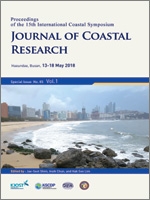Woo, H.J.; Lee, J.-H.; Kang, J., and Choi, J.U., 2018. Sedimentary processes of barrier-lagoon system in the Nakdong river estuary, Busan, South Korea. In: Shim, J.-S.; Chun, I., and Lim, H.S. (eds.), Proceedings from the International Coastal Symposium (ICS) 2018 (Busan, Republic of Korea). Journal of Coastal Research, Special Issue No. 85, pp. 1–5. Coconut Creek (Florida), ISSN 0749-0208.
The Nakdong River Estuary on the southeastern coast of the Korean Peninsula is enclosed by two large estuarine dams, one constructed in 1934, and one between 1983 and 1987. The estuary has been characterized as a barrierlagoon system with various subenvironments and micro-tidal ecosystem and a mean tidal range of 1.07 m. The monitoring short-term sedimentation rates and suspended sediment characteristics were investigated to understand sedimentary processes in the barrier-lagoon system of the Nakdong River Estuary. The surface sediments generally showed sand sediment was dominated along the seaward side of the barrier islands and muddy sand sediment was dominated within the lagoon. The short-term sedimentation rates for a year showed that deposition dominated the tidal flats between the mainland and Jinudo (JW-line) and the mainland and Sinjado (SJ-line), with net deposition rates of 10.09 and 12.38 mm/year, respectively. Erosion dominated the tidal flat for two years at the southern end of Eulsukdo (ES-line), which is located on the eastern side of the system, at an annual rate of −12.76 mm/year. Four 12.5-hour anchoring surveys conducted at the inlets and channel revealed that net suspended sediments were transported to the open sea during a tidal cycle in summer. The sedimentary processes of the Nakdong River Estuary showed that sediments were transported into the lagoon through inlets during floods and moved westward and/or northwestward; they were then deposited on the tidal flats and in channels near the dams under low energy conditions. Within the eastern side of the system, sediments flowed out of the sea with discharge from the Nakdong Dam during ebb conditions. The major control factors for seasonal variations in these sedimentary processes within the barrier-lagoon system were waves, tidal currents, and dam discharges.





